Measuring of Satisfaction and Post-Purchase Process in Services
- 1. Name: Umair Usman Registration # 36833 Program: MBA (Weekend) Semester: III Course: Methods in Business Research Topic: Measuring of Satisfaction and Post-Purchase Process in Services Submitted to: Muhammad Mumtaz Khan Submission date: February 22nd 2015
- 2. Table of Content Introduction 1 Literature Review 2 Satisfaction and decision making process 2 Post-purchase and Regret 2 ŌĆō 4 Post-purchase and Satisfaction 4 Conceptual Frame work 5 Research Design 6 Research Methodology 7 Sample Design 7 Questionnaire Design 7 Data Collection 7 Data Analysis 7 Analysis 8 Result & Conclusion Questionnaire References
- 4. 2 Literature Review Satisfaction and decision making process The process of need satisfaction arises from the identification of gap between the current state and the desire state. When an individual feel the need, he/she search product to fulfill those needs. In order to get maximum satisfaction they look for the best product. Sellers identified various influences for buyers who actually make the buying decision, the types of buying decision and stages of buying process (Kotler, 2002). To manage these situations decision theory buyer uses their analytical thinking and compare the consequences of each alternative in term of higher benefits, lowest the cost and on a long run basis (Hansson 2005; North 1968; Tryfos 2001). After making a purchase consumer moves into final stage of buying process where they experience of satisfaction or dissatisfaction. The closeness between the buyerŌĆÖs expectations and the product perceived performance (Rodgers et al. 1989). As the whole process of purchasing there is beginning of another process which is known as the post purchase evaluation. The consumer has an internal war with themselves on whether or not the purchase was right for them (Boundless 2014). At this point we draw attention towards dilemma that at the time of purchase it sounds like a good idea. Then once it is done, it may not be exactly the same what you originally wanted. And now they look back on their decision whether it was right. As they may have extra money so they bought it (Boundless 2014). This experience leads them towards their perception generation. And they use reference group, opinion leaders, and influence in their decision to satisfy their needs. And this develops their behavior towards whole process which the individual pass through. Post-purchase and Regret This experience further elaborated by researchers through dividing it into Counterfactual thinking. Counterfactual thinking (CFT): It is the feelings to satisfy one own self by creating an alternative imagination to better satisfy their needs (Zeelenberg and Pieters 2006; cited by Lee
- 5. 3 and Cotte 2009). Counterfactual thinking (CFT) is the process of comparing reality with alternative possibilities by constructing hypothetical scenarios to assess the attractiveness of alternative possibilities (Kahneman and Miller 1986; cited by Lee and Cotte 2009). In post purchase, an individual stand on two stages upward CFT and downward CFT (Kahneman and Miller 1986). Downward counterfactual thinking occur when an individual imagine that the situation may get worse if he/she selected the other alternative. And the upward CFT is the perception that situation may get better if the other alternative was selected. LetŌĆÖs focus on upward CFT, where individual focus on better option. In this scenario the unavailability of alternative may also become the source of regret (Lee and Cotte 2009). These feelings of disappointment occur due to over estimation which generating the experience of how the individual bought and what they bought. Several author suggested that when unfavorable outcome compared with the better outcome the regret generated (Bell 1982; Tsiros and Mittal 2000; cited by Lee and Cotte 2009). To manage this dissonance, there are efforts made by various forces in the environment, like individual defense mechanism active itself to justify its choice and provide reasons and pros and try to reduce anxiety. Then sellers also work on this by two techniques pre-purchase and post purchase. The pre- purchase activity for profit like before purchase they gives lower price so that they can attract new customer and/or offer free gift or some extra services to generate higher value and reduce or avoid post purchase regret, which is product not meet the desire expectations (Kuksov and Xie, 2008). As the following discussion show the post purchase strategy is to provide extra efforts, not promised before purchase, to serve customers. As this depends on situation if market is not growing fast the firm may reduce first-period price and provide extra post-purchase efforts (Kuksov and Xie, 2008). Some practices are sending thank you notes, advertise the product in superior ads, and they can offer guarantees for their products.
- 6. 4 Now the focus of this thesis is the problem with getting dissonance from services that you cannot return. Due to their invisibility, inseparability, permissibility and variability characteristics services, consumers are more adopt various measures to judge, buy and recommend others such as intangibility makes assessing quality and value is difficult. And the client will never know its goodness, until he/she experienced it. In order to overcome this fact, marketers heavily relay on services process, deliverables, personal interaction, trusted recommendations, clear communications and benefits to build clientŌĆÖs confidence (ReThink Marketing nd). Post-purchase and Satisfaction The factor of post-purchase in services has been underestimated, as the nature of this makes it different from tangible product study. Study establish on the find that elements such as satisfaction influence repeat visiting and recommending the experience to others (Harrison and Shaw 2001; 2004). The importance of satisfaction in services are recognizing by word-of-mouth communication (Young 1981; cited by Harrison and Shaw 2004). We can assume that the existence of service firm is widely depending on the satisfaction level of its consumers. Despite the brand equity factor is has been maintain the view the satisfied customers are believed to affect the long-term viability of organizations through repeat purchase, brand loyalty and word-of-mouth communication (Cina 1989; Churchill and Surprenant 1982: Walker 1995; cited by Harrison and Shaw 2004). And in services people, place, physical environment counted for it value creation. There is a reality the consumer might not visit after they become dissatisfied by provider, this evidence by one client level measured by repeated visit, and continuously service delivery or consumption process (Gabbott and Hogg 1998; cited by Harrison and Shaw 2004). The writers make evaluation of post-purchase trend in services through measuring the consumerŌĆÖs expectations and their willingness to fulfill them, which are affected by environment ŌĆō place and/or surrounding where the actual delivery of services takes place, people who provide the services and the process in which consumer and service provider involve to deliver the service.
- 7. 5 Conceptual Frame Work of Satisfaction and Post-purchase Behavior in Services The initial conceptualize work in figure-1 was construct after above discussion. This frame of hypothesis was tested on the level of satisfaction from services availed by selected population. It shows describe the relationship between variable cause behavior towards post-purchase. We have also discussed the various level of satisfaction (upward & downward) after making the final purchase. Due to the nature of services, consumersŌĆÖ behavior in post-purchase, on this particular nature of product, is different. And we try to measure the impact of this changes cause to perishability, inseparability, intangibility and heterogametic element makes it quiet difficult to study the effects on re-buying. H1: Fulfillment of expectation is associated with satisfaction H2: Customer satisfaction is directly affects the post purchase behavior of the product H3: Satisfaction of customer depend on their expectation and service delivery These hypotheses tell us about the desirability and intention to re-buy. The consumersŌĆÖ achievement of need fulfillment from the product makes their inner satisfaction and they recommended to other. H4: Word of mouth only create attention of customer toward product The referral group, inner-circle and opinion leaders help the individual in their decision making while they are uncertain on product purchase. Word-of mouth leads or guide on the occasion when the person is involve in dilemma whether to purchase or not. And they may also serve as decision maker in post-purchase. Post-purchase Satisfaction Recommendation Word-of-mouth Expectations Performance Figure 1 Conceptual Frame Work of Satisfaction and Post-purchase Behavior in Services
- 8. 6 Research Design This is the exploratory research to measure the level of satisfaction and intention for post- purchase in services. As service product share distinguish characteristics, we try to analysis the trend followed in service toward post-purchase. In order to perform our study, as this research is descriptive, we use cohort study as the sample group shares the same time period of the service availability within a limited geographic region. The majority of the sample size was depends on metropolitan city and financial stabilized. Here we deal with the process problem as with the passage of time the variation gives impact on consumer behavior towards particular needs. Their past experience and word-of-month also play major role while they were trying new product.
- 9. 7 Research Methodology Sample Design Our sample was consists of 20 individuals, who live in metropolitan, graduates, internet user, and income group belongs mid-level. Questionnaire Design For primary data collection, we use questionnaire approach. It consists of 15 questions, all are closed ended and range from likert scale to two options. Data Collection Data collection performed through google.doc, and the questionnaire spread from social media. Data Analysis Data analysis performed on SPSS.
- 10. 8 Analysis
- 12. 10 Questionnaire Q.1) How old are you? 20 ŌĆō 30 31 ŌĆō 45 46 ŌĆō 60 Q.3) What is your gender group? Male Female Q.3) Income group you belong. Rs. 20,000 ŌĆō 35,000 36,000 ŌĆō 50,000 60,000 ŌĆō above Q.4) Please mark all types of services you regularly avail to; Food News Teaching Barber/pallor Fitness Security Cleaning Q.5) For the following statement please tick Ō£ō the box that matches your view most closely; ŌĆśI feel that too much time was invested in getting this product.ŌĆÖ Agree Slightly agree Neutral Slightly disagree Disagree Q.6) How often do you feel the following statement is true with you, ŌĆśWith more information, I feel that I could have made a better decision.ŌĆÖ All the time Frequently Sometime Rarely Never Q.7) Using community service is a social status symbol. Yes No
- 13. 11 Q.8) How do you feel about the following statement? ŌĆśI should have chosen something else than the one I bought.ŌĆÖ Strongly Agree Agree Neutral Disagree Strongly Disagree Q.9) How many times your expectation meet your satisfaction level? Never One Time Two Times Three Times More than Four Times Q.10) Do you think the satisfactory support service increases the chances to visit the retailer next time? Strongly Agree Agree Neutral Disagree Strongly Disagree Q.11) If I were to go back in time, I would choose something different to buy. Agree Disagree DonŌĆÖt know Q.12) What are the things which delight you while getting service; Product People (service provider/staff) Environment (surrounding) Price Q.13) How is purpose to complete word-of-mouth connected to actual performance? Ideal Desired Needed Adequate Q.14) What situations enable you to rely on word of mouth? New buying Complex buying Same product but new service provider Modified re-buy Q.15) How effectively your existing referral cause in generating trial for the product purchase? 81% - 100% 61% - 80% 41% - 60% 21% - 40% 0% - 20%
- 14. 12 References 1. Boundless ŌĆśPostpurchaseŌĆÖ [online] (03 Jul. 2014) Available from <https://www.boundless.com/marketing/textbooks/boundless-marketing- textbook/consumer-marketing-4/consumer-decision-process-40/postpurchase-204- 10576/> 2. Harrison, Paul and Shaw, Robin (2004) ŌĆÖConsumer Satisfaction and Post-purchase Intentions: An Exploratory Study of Museum VisitorsŌĆÖ, International Journal of Arts Management; 6:2, p.23. 3. Kotler, Philips (2002) Marketing Management Millennium Edition (10th Edn), Pearson Custom Publishing, United State of America. 4. Kuksov, Dmitri and Xie, Ying (2008) ŌĆśPre- and Post-Purchase Management of Customer SatisfactionŌĆÖ 3-8. 5. Lee, Seung and Cotte, June (2009) ŌĆśPost-Purchase Consumer Regret: Conceptualization and Development of the PPCR ScaleŌĆÖ. Advances in Consumer Research, Volume 36, 456-457. 6. North, D. Warner (1968) ŌĆ£A tutorial introduction to Decision TheoryŌĆØ IEEE Transactions on systems science and cybernetics, Vol., SSC-4, No. 3, 7. Rethinkmarketing ŌĆśServices Marketing: Four Factors that Affect Your CustomersŌĆÖ [online] Available from www.rethinkmarketing.com/articles/ReThink Marketing - Strategic Marketing, Research, & Planning Consultants.htm#top 8. Tryfos, Peter (2001) Decision Theory, Canada, Chapter 3

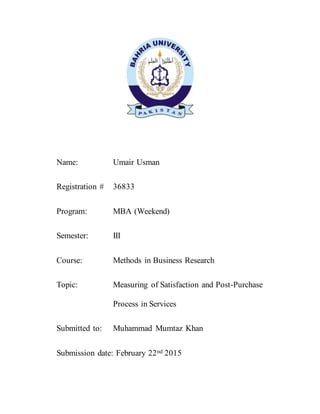



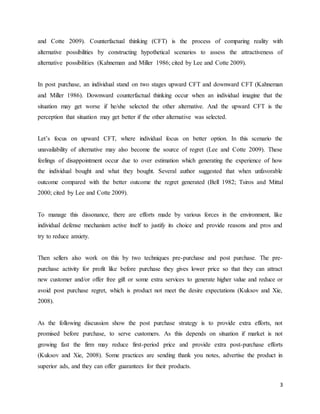
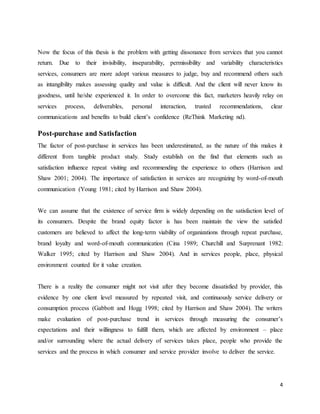




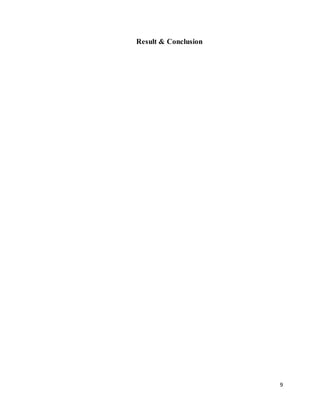
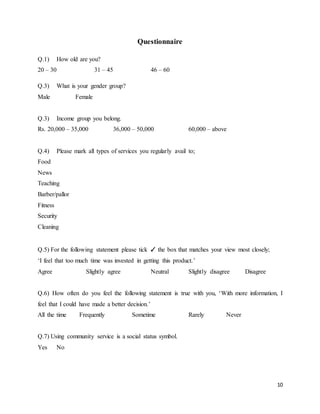
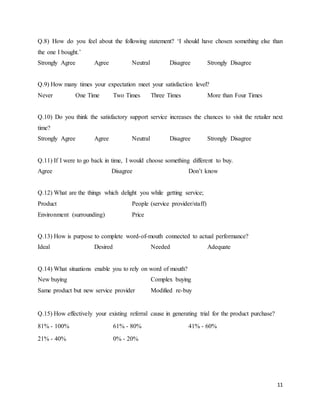
![12
References
1. Boundless ŌĆśPostpurchaseŌĆÖ [online] (03 Jul. 2014) Available from
<https://www.boundless.com/marketing/textbooks/boundless-marketing-
textbook/consumer-marketing-4/consumer-decision-process-40/postpurchase-204-
10576/>
2. Harrison, Paul and Shaw, Robin (2004) ŌĆÖConsumer Satisfaction and Post-purchase
Intentions: An Exploratory Study of Museum VisitorsŌĆÖ, International Journal of Arts
Management; 6:2, p.23.
3. Kotler, Philips (2002) Marketing Management Millennium Edition (10th Edn), Pearson
Custom Publishing, United State of America.
4. Kuksov, Dmitri and Xie, Ying (2008) ŌĆśPre- and Post-Purchase Management of Customer
SatisfactionŌĆÖ 3-8.
5. Lee, Seung and Cotte, June (2009) ŌĆśPost-Purchase Consumer Regret: Conceptualization
and Development of the PPCR ScaleŌĆÖ. Advances in Consumer Research, Volume 36,
456-457.
6. North, D. Warner (1968) ŌĆ£A tutorial introduction to Decision TheoryŌĆØ IEEE Transactions
on systems science and cybernetics, Vol., SSC-4, No. 3,
7. Rethinkmarketing ŌĆśServices Marketing: Four Factors that Affect Your CustomersŌĆÖ
[online] Available from www.rethinkmarketing.com/articles/ReThink Marketing -
Strategic Marketing, Research, & Planning Consultants.htm#top
8. Tryfos, Peter (2001) Decision Theory, Canada, Chapter 3](https://image.slidesharecdn.com/40951744-0539-4f10-a915-9e9c50330b27-160116041254/85/Measuring-of-Satisfaction-and-Post-Purchase-Process-in-Services-14-320.jpg)